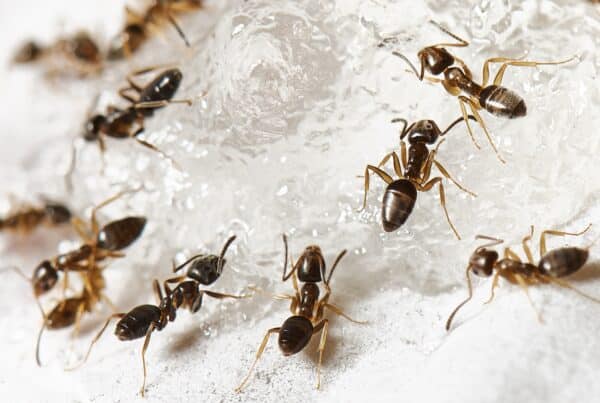
Controlling ant infestations with natural methods like diatomaceous earth has become an increasingly popular topic for anyone seeking to build a solid preventative routine for their home. But does diatomaceous earth really kill ants?
In this article, we’ll explore what exactly diatomaceous earth is and whether it’s an effective solution for ant problems. By the end, you’ll have a better understanding of this unique pest control method and whether it deserves a place in your ant management strategy.
What is Diatomaceous Earth?
Diatomaceous earth, often referred to simply as DE, is a naturally occurring sediment made up of fossilized remains of diatoms. Diatoms are microscopic, single-celled algae that have skeletons made of silica. Over long periods, these diatom skeletons accumulated and formed large deposits of diatomaceous earth.
DE is mined from these deposits and then milled into a fine, chalky powder. There are two main grades of diatomaceous earth – food grade and filter grade. Food grade DE is considered non-toxic and safe for use around homes and gardens. Filter grade DE contains higher levels of silica and is not suitable for pest control purposes.
How Does it Work?
DE kills ants through a mechanical process rather than a chemical one. The microscopic particles of DE are sharp and abrasive, which can cut through the exoskeletons of ants and other insects.
When ants come into contact with DE, it adheres to their bodies and absorbs the oils and fats from their exoskeletons, leading to dehydration and eventual death

Diatomaceous earth application to a garden, preventing pests.
Application Guidelines
To get the most out of diatomaceous earth for ant control, proper application is crucial. So, here are some best practices to follow:
1) Identify Ant Trails and Nests: Locate where ants are most active. Common areas include along baseboards, window sills, cracks, and around ant mounds outdoors.
2) Apply a Thin Layer: Sprinkle a thin layer of DE directly onto the ant trails and around their nests. Indoors, you can also dust areas where ants are entering your home, such as doorways and windows.
3) Create Barriers: For a preventative measure, spread a barrier of DE around your home’s perimeter. This can help stop ants from entering in the first place.
4) Use in Dry Conditions: DE loses its effectiveness when wet, so it’s best to use in dry weather. If DE gets wet, reapply once it’s dry.
5) Direct Application: For immediate effect, you can apply DE directly to visible ants or sprinkle it into their nests. This method works well for small infestations.
6) Reapply Regularly: Outdoors, reapply DE every 1-2 weeks or after rain. Indoors, it should be replenished every 1-2 months, or whenever you vacuum up dead ants and old powder.

Other Recommended Maintenance
To ensure long-term success in controlling ant infestations, it’s important to incorporate additional maintenance strategies alongside using diatomaceous earth:
- Keep Your Home Clean: Regularly clean up food crumbs, spills, and other attractants. Ants are constantly in search of food, so eliminating their food sources is crucial.
- Seal Entry Points: Inspect your home for cracks, gaps, and other entry points that ants might use. Use caulk or weather stripping to seal these openings and prevent ants from finding a way inside.
- Maintain Your Yard: Keep your yard tidy by trimming back plants and shrubs that are close to your home. Remove piles of leaves, wood, and other debris where ants might nest.
- Proper Food Storage: Store food in airtight containers and ensure pet food is stored tightly. This minimizes the availability of food sources for ants inside your home.
When to Call a Professional
If you still face persistent ant issues, it’s likely time to call in the experts. Persistent infestations often signal a more significant problem that needs professional treatment.
For large infestations spanning multiple areas of your home or yard, pest control professionals can provide a comprehensive approach. Sometimes, identifying the exact source of an ant infestation can be challenging. Professionals have the expertise and tools to locate and treat ant nests effectively.
In scenarios where natural methods are insufficient, professionals can safely apply more potent chemical treatments.
Conclusion
All in all, diatomaceous earth will kill ants and can be a natural option for pest management, to an extent. Its microscopic silica particles are lethal to ants but gentle for homes with children and pets.
While diatomaceous earth alone may not eliminate major infestations, it can significantly thin out ant populations over time as part of an integrated approach. To get help with an existing ant issue, schedule other pest control services, or set up an in-depth home inspection, reach out to Honor Services in Melbourne, FL, and surrounding areas today.



